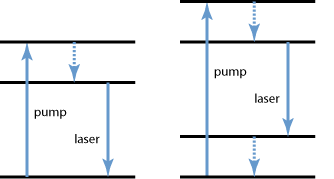I'm wondering about achieving population inversion for a laser. I learned that without an active medium, it's not possible to create a laser with only two energy levels, but it would be possible with three. What is the advantage of having four levels then?
4 Answers
When you have a three-level system, the laser transition is between the ground and first excited levels (see figure). In this scheme, it is rather challenging to get population inversion because all atoms tend to stay on the lowest level.
With a four-level scheme, you have an extra level so that the laser transition does not end in a ground state. Thus, if the bottom level gets depopulated faster than the top level in the laser transition the population inversion will be guaranteed independent of how fast or efficiently you pump the system. Many lasers, such as Nd:YAG or HeNe laser to name a few, actually use a four-level scheme exactly for this reason.

-
$\begingroup$ I don't understand what happens after the "laser" from E3 -> E2 in the second picture. What happens at the transition from the second level to the ground state? $\endgroup$– Ci3Commented Feb 13, 2013 at 23:30
-
1$\begingroup$ That is just some non-radiative transition (e.g. through collisions) that, if faster than decay from E$_3$ to E$_2$, guaranties that the population inversion will be achieved. $\endgroup$ Commented Feb 14, 2013 at 8:14
If you have a fast non-radiative transition to the ground state from the bottom laser level, that would help with population inversion because you're emptying the bottom laser level.
-
$\begingroup$ What you mentioned is correct for three-level scheme. What is the advantage of fourth level? $\endgroup$– MishaCommented Feb 14, 2013 at 10:29
As pointed out in the other answers, you can build perfectly fine lasers with 3-level and 4-level schemes. However, I would like to add that generally speaking, 4-level schemes exhibit a lower inversion threshold (power or intensity) whereas 3-level schemes tend to be more efficient regarding the conversion of input to output power.
In a 4-level system, due to the usually low thermal population of the 2nd lowest energy level, it is easier to achieve population inversion between the 3rd and 2nd energy level (corresponding to the laser transition), hence achieving inversion at a lower pump power/intensity. On the other hand, more energy is lost through non-radiative decays between the 4th and 3rd and the 2nd and 1st energy level, reducing the overall efficiency compared to a 3-level scheme where only one such non-radiative decay occurs.
But this is just a general picture and exceptions will apply.
The lower level of laser transition is above the ground state,this means that the fast non-radiative transfer from the lower laser level to ground state keeps a reasonable population in the upper laser level(3rd) which is fundamental for lasing.Hence its more effective than 3-level system
